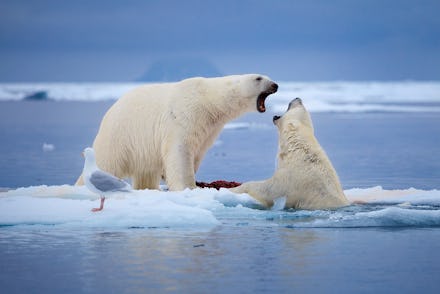Why Are the Glaciers Melting? Blame These Asshole Microbes

Glaciers are melting faster than they should, and new research may explain why.
Microbiologists from Aberystwyth University in Wales believe Arctic microbes are contributing to glacial melting, due to a process that hadn't been previously recorded in climate change models.
According to Dr. Arwyn Edwards, the lead researcher, there's a soil-like substance on Arctic ice called cryoconite, which is basically just dust and soot "glued" together with bacteria.
The team found that on an ice sheet in Greenland, the microbes were darkening the surface of the ice and melting little holes into it, like the salt you throw down on an iced-over sidewalk. Except unlike sidewalk salt, these microbes love sunlight, so they make their holes deeper and wider to get more exposure, which means more melting.
And when the holes get bigger, other bacteria that can handle the warmed-up conditions of the glacier move into the water pools, meaning the holes continue to grow.
According to the research, arctic ice reflects around 60% of the sunlight that hits it. But when pocked with cryoconite, that rate goes down to 20%, sucking up way more solar energy and heating up the ice sheet like a popsicle on a hot sidewalk.
"If we recognize ice surfaces as a living landscape, we can see that the microbes themselves are able to change the glacial surface," Edwards said in a press release. "It's only recently that we've begun to understand that these cryoconite holes are dynamic, changing in size and shape. Microbes are capable of ecosystem engineering and respond to changes in their environment all the time."
The researchers make no mention of how to get the cryoconite, specifically from the genus Phormidesmis, from setting up shop on a glacier. But they know it's happening because, thanks to climate change, the surface ice is just hospitable enough to grow bacteria. If the planet keeps getting warmer, more of this bacteria will grow, and our sea level will rise that much faster.